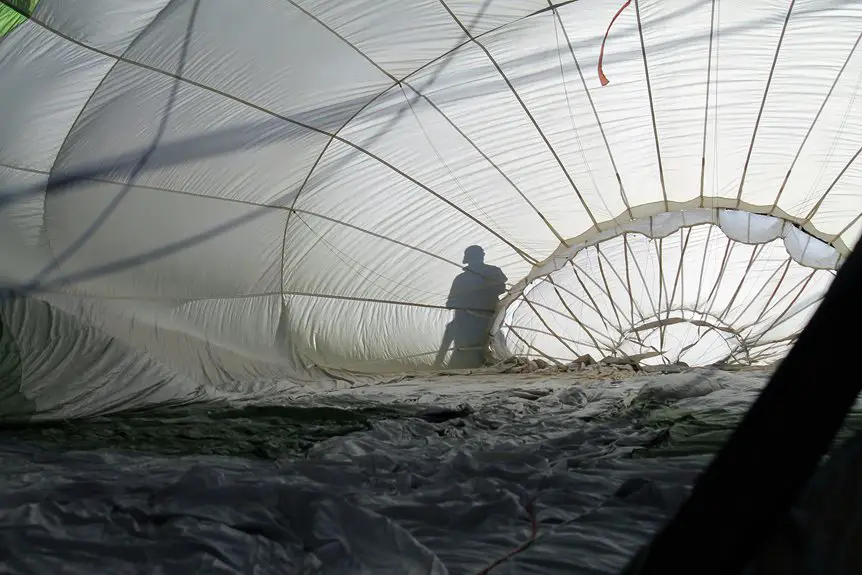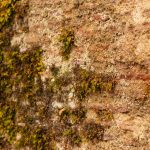When you choose Kevlar parachute fabric, you get unmatched strength and durability for demanding aeronautical uses. Kevlar’s high tensile strength, cut resistance, and thermal stability help your parachute withstand intense forces, abrasion, and environmental wear better than traditional nylon or polyester. This means safer, more reliable deployments and longer service life. Plus, its lightweight nature improves maneuverability and control during descent. Exploring its design and manufacturing reveals even more about why Kevlar stands out in aeronautics.
Table of Contents
Key Takeaways
- Kevlar’s exceptional tensile strength and lightweight properties make it ideal for durable, high-performance parachute fabrics in aeronautics.
- Its superior resistance to tearing, abrasion, and UV degradation enhances parachute safety and longevity during high-stress deployments.
- Kevlar parachutes maintain shape and reliability under rapid deceleration and thermal stress from air friction in flight conditions.
- Military and civilian parachutes utilize Kevlar to balance strength, flexibility, and reduced weight for improved maneuverability and control.
- Advanced weaving patterns and precision manufacturing techniques optimize Kevlar fabric’s performance in demanding aeronautical applications.
Properties of Kevlar Relevant to Parachute Fabric
Kevlar stands out for its exceptional strength-to-weight ratio, making it ideal for parachute fabric. You’ll appreciate how this synthetic fiber provides incredible tensile strength without adding bulk, ensuring your parachute remains lightweight yet durable.
It resists stretching under stress, so it maintains shape and performance during deployment. Kevlar’s high thermal stability means it withstands heat caused by air friction and rapid deceleration without degrading.
Plus, it’s naturally resistant to abrasion and cuts, protecting your parachute from wear and tear during repeated use. Its low elongation prevents sudden failures, giving you consistent reliability.
When you choose Kevlar for parachute fabric, you get a tough, reliable material that enhances safety and performance in demanding aeronautical conditions.
Historical Development of Kevlar in Aeronautics
You’ll find that Kevlar’s early adoption in aeronautics revolutionized safety standards across the industry.
It quickly became a go-to material for parachute fabric due to its strength and durability.
Understanding this history helps you appreciate how Kevlar continues to protect lives today.
Early Kevlar Adoption
Although synthetic fibers had been explored for decades, it wasn’t until the 1960s that aeronautical engineers began seriously testing Kevlar for parachute fabric.
You’d find Kevlar’s unique strength-to-weight ratio and resistance to stretching ideal for parachutes, which demand reliability under extreme stress.
Early adoption focused on integrating Kevlar threads into woven parachute canopies, aiming to enhance durability without adding bulk.
You’d see initial trials proving that Kevlar could withstand higher impact forces and resist tearing better than traditional nylon fabrics.
As a result, manufacturers started experimenting with hybrid designs, combining Kevlar with existing materials to balance performance and cost.
Impact on Safety Standards
When aeronautical engineers recognized the superior strength and durability of Kevlar parachute fabric, they pushed for stricter safety standards to reflect its capabilities.
You’ll find that these updated standards demanded higher tensile strength and improved tear resistance, directly enhancing parachute reliability. As a result, manufacturers had to meet rigorous testing protocols, ensuring every Kevlar parachute could withstand extreme conditions.
This shift not only raised the bar for material performance but also reduced failure rates considerably. By adopting Kevlar, safety regulations evolved to prioritize long-term durability and pilot protection.
You benefit from these advancements because modern parachutes offer greater confidence during deployment, especially in emergency scenarios.
Ultimately, the integration of Kevlar transformed safety standards, making aeronautical operations safer and more dependable for everyone involved.
Comparison Between Kevlar and Traditional Parachute Materials
When you compare Kevlar to traditional parachute materials, you’ll notice significant differences in durability and strength.
Kevlar offers superior resistance to tearing while staying lightweight and flexible.
Understanding these contrasts helps you appreciate why Kevlar has become a preferred choice in modern parachute design.
Durability and Strength Differences
Because you rely on parachute fabric to perform flawlessly under extreme conditions, understanding the durability and strength differences between Kevlar and traditional materials is essential.
Kevlar outperforms nylon and polyester in tensile strength, meaning it can withstand greater force without tearing. This superior strength translates into enhanced safety and reliability during deployment.
Kevlar also resists abrasion and cuts better, so it endures rough landings and environmental wear longer than traditional fabrics. Additionally, Kevlar’s resistance to UV degradation keeps it dependable over extended use.
While conventional materials tend to weaken faster under stress, Kevlar maintains its integrity, reducing the risk of failure.
When choosing parachute fabric, you’ll find Kevlar’s durability and strength provide a critical advantage in demanding aeronautical applications.
Weight and Flexibility Comparison
Although Kevlar offers exceptional strength, it also manages to stay surprisingly lightweight, which can make a big difference in parachute performance. When you compare it to traditional materials like nylon and silk, you’ll notice Kevlar reduces overall weight without sacrificing flexibility. This means you get easier handling and faster deployment. Check out the comparison below:
| Property | Kevlar | Traditional Nylon |
|---|---|---|
| Weight (g/m²) | 110 | 130 |
| Flexibility | High (retains shape) | Moderate |
| Durability | Very High | Moderate |
With Kevlar, you gain lighter gear and better flexibility, enhancing your parachute’s responsiveness and safety.
Design Considerations for Kevlar Parachutes
To design a Kevlar parachute that performs reliably, you’ll need to carefully balance strength, weight, and flexibility. You must select the right weave pattern to optimize tensile strength without adding unnecessary bulk.
Additionally, consider how the fabric’s flexibility impacts packing and deployment—too stiff, and the canopy won’t open smoothly; too loose, and it may wrinkle or deform.
You’ll also want to factor in environmental resistance, ensuring the material can withstand UV exposure and moisture without degrading.
Seam placement and reinforcement require attention too, as improper stitching can compromise performance.
Finally, test your design under real conditions to verify it meets aerodynamic and safety standards. By focusing on these elements, you’ll create a Kevlar parachute that’s both efficient and dependable.
Strength and Durability Benefits in Deployment
When you deploy a Kevlar parachute, its exceptional strength and durability come into play immediately, ensuring reliable performance under intense conditions.
Kevlar fibers resist tearing and withstand the sudden forces experienced during deployment, so you won’t worry about fabric failure. The high tensile strength keeps the canopy intact, even when subjected to rapid acceleration and turbulent airflow.
You benefit from Kevlar’s resistance to abrasion and environmental factors like moisture and UV exposure, which means the parachute maintains integrity over multiple uses. This durability reduces maintenance needs and extends service life, providing consistent safety.
When seconds matter, you can trust Kevlar parachute fabric to hold up, delivering dependable deceleration and controlled descent every time you jump or eject.
Weight Reduction and Its Impact on Performance
Since every ounce counts in parachute design, Kevlar’s lightweight nature considerably enhances overall performance. You’ll notice improved maneuverability and faster deployment times because the fabric reduces the parachute’s bulk. This means you can carry less weight without sacrificing strength or safety. Using Kevlar also decreases the load on the user, making long missions less taxing. Here’s a quick look at how weight reduction with Kevlar impacts key performance factors:
| Performance Factor | Impact of Weight Reduction |
|---|---|
| Deployment Speed | Faster due to lighter fabric |
| Maneuverability | Improved control and agility |
| User Fatigue | Reduced strain during operations |
| Load Capacity | Increased payload potential |
| Safety Margin | Maintained with less fabric weight |
Resistance to Environmental Factors and Abrasion
Durability defines Kevlar parachute fabric’s strength against harsh environmental conditions and abrasion. When you rely on parachute fabric, you need materials that withstand extreme weather without losing integrity.
Kevlar resists UV radiation, moisture, and temperature fluctuations, ensuring consistent performance. It also endures friction and rough landings better than many alternatives, keeping you safe during every deployment.
Kevlar withstands UV rays, moisture, and rough impacts, delivering reliable performance when safety matters most.
Consider these key resistance features:
- UV Resistance: Maintains strength under prolonged sun exposure
- Moisture Repellence: Prevents weakening from rain or humidity
- Abrasion Resistance: Withstands wear from rough surfaces and repeated use
With Kevlar, you get a fabric that holds up in tough environments, helping you trust your gear no matter the conditions.
Safety Enhancements Provided by Kevlar Fabric
Kevlar’s ability to resist environmental damage and abrasion directly boosts your safety during parachute deployment. It guarantees your canopy maintains integrity under stress, reducing the risk of tears or failures mid-air. Kevlar’s lightweight yet strong fibers also improve your control and stability, giving you confidence during descent. Here’s how Kevlar enhances your parachute safety:
| Safety Feature | Benefit |
|---|---|
| High Tensile Strength | Prevents fabric rupture under load |
| Abrasion Resistance | Maintains canopy durability over time |
| Heat Resistance | Protects from friction-generated heat |
| Lightweight | Enhances maneuverability and reduces fatigue |
With Kevlar, you get a reliable, tough fabric that safeguards your jump, guaranteeing your parachute performs efficiently when it matters most.
Applications in Military and Civilian Parachuting
Whether you’re a soldier on a mission or a recreational jumper, Kevlar parachute fabric plays an essential role in ensuring safety and performance. You rely on its strength to withstand harsh conditions and rapid deployment forces.
Military applications benefit from Kevlar’s resistance to tears and abrasions, critical for combat jumps and tactical maneuvers. For civilian parachuting, the fabric offers durability and lightweight comfort, enhancing your overall experience.
Kevlar fabric is favored because it:
- Resists high-impact stresses during sudden openings
- Provides exceptional durability against environmental wear
- Maintains flexibility for better maneuverability in the air
Manufacturing Techniques for Kevlar Parachutes
Creating Kevlar parachutes involves several specialized manufacturing techniques that guarantee the fabric performs reliably under extreme conditions. You start by weaving Kevlar yarns into a tight, ripstop pattern, enhancing tear resistance. Then, you apply coatings to improve UV and moisture protection. Finally, precision sewing assembles the panels, ensuring strength and aerodynamic shape.
| Step | Technique | Purpose |
|---|---|---|
| Weaving | Ripstop pattern | Tear resistance |
| Coating | UV/moisture shield | Durability |
| Sewing | High-strength seams | Structural integrity |
Future Trends and Innovations in Kevlar Parachute Technology
Advances in manufacturing have set the stage for exciting developments in Kevlar parachute technology.
You’ll see innovations that enhance durability, reduce weight, and improve deployment reliability. These trends aim to make parachutes safer and more efficient for various aeronautical uses.
Look out for:
- Smart fabrics that monitor stress and wear in real time, alerting you to potential failures.
- Enhanced weaving techniques that increase strength without adding bulk, keeping your gear lightweight.
- Integration of nanomaterials to boost heat resistance and tear toughness, extending the parachute’s lifespan.
Frequently Asked Questions
How Should Kevlar Parachutes Be Maintained for Long-Term Use?
Did you know Kevlar is five times stronger than steel? You should regularly inspect your parachute for tears, clean it gently with mild soap, avoid prolonged UV exposure, and store it in a cool, dry place to guarantee durability.
Can Kevlar Parachutes Be Recycled or Repurposed After Use?
You can recycle or repurpose Kevlar parachutes, but it’s tricky due to their tough fibers. Look for specialized recycling programs or get creative by turning them into durable bags, covers, or protective gear.
What Is the Average Cost Comparison of Kevlar Parachutes Versus Nylon Ones?
You’ll find Kevlar parachutes cost considerably more than nylon ones, often two to three times higher, due to Kevlar’s superior strength and durability. However, that investment usually pays off with enhanced safety and longevity.
Are There Any Health Risks Associated With Handling Kevlar Fabric?
You shouldn’t face major health risks handling Kevlar fabric, but cutting or sanding it may release dust that can irritate your skin, eyes, or lungs. Wearing protective gear and working in ventilated areas helps keep you safe.
How Does Kevlar Perform in Extreme Cold Compared to Other Materials?
They say, “When the going gets tough, the tough get going.” In extreme cold, you’ll find Kevlar keeps its strength better than many materials, ensuring durability and protection when temperatures drop drastically.
- Does Chiffon Fabric Stink - July 15, 2025
- Does Chiffon Fabric Affect the Economy - July 15, 2025
- Does Cotton Fabric Have a Nap - July 15, 2025







